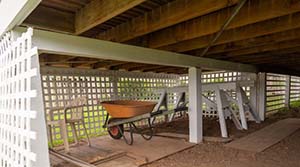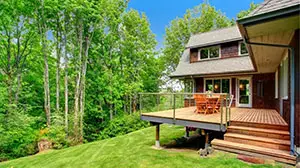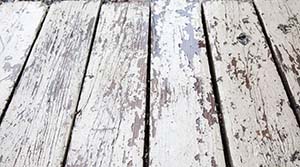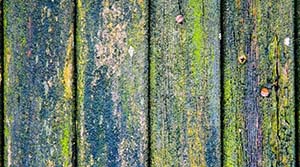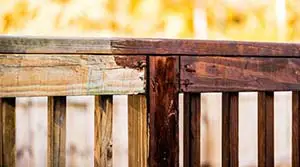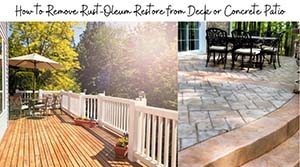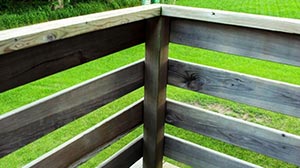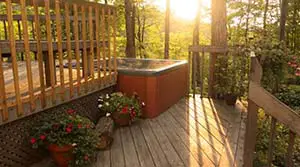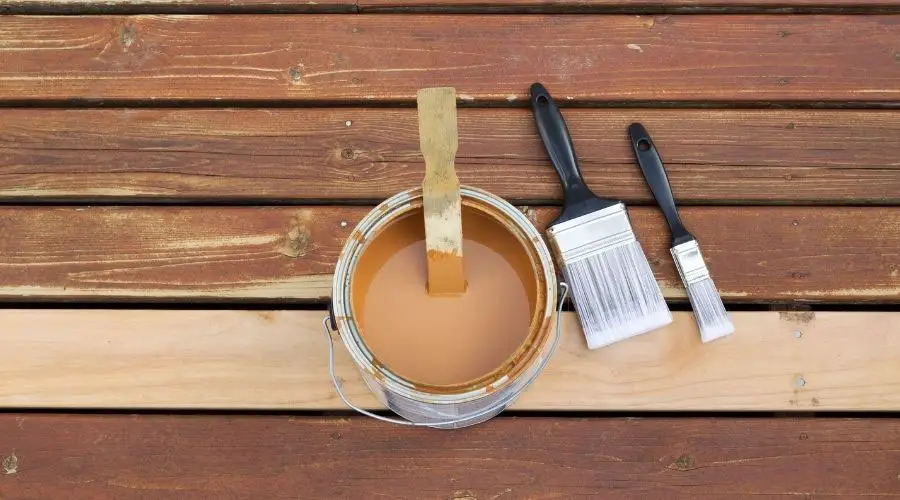
If you have a deck that you would like to stain, you need to find a suitable color. But to do so, you have to consider several factors.
Below are some things you should think about when choosing a deck stain color that suits your house.
- The budget
- The environmental conditions
- Your deck’s existing condition
- The primary purpose of the stain
- The type of wood material that makes up your deck
- The eco-friendliness of the stain
- The exterior of your home
- The maintenance requirements
It would help if you first understood what a deck stain is or is not and when to use it before selecting one for your house. This article discusses these things and provides a detailed breakdown of how to choose deck stains.
What is a Deck Stain?
A deck stain is any coating product you can use to change the deck’s appearance and color. It tends to contain a colorant of some kind which is usually dissolved or suspended in a solvent.
Typical solvents include finishing agents such as shellac or polyurethane. And others consist of alcohol, water, or different types of petroleum distillates.
Generally, deck stains have varying levels of opacity.
Why Should You Use Deck Stains?
People tend to stain their decks for various reasons. It helps to know what these reasons are to determine whether you should invest in deck staining.
1. Protects the Deck from the Sun
The first reason is to protect the deck from prolonged exposure to sunlight, which causes aging faster. The stains do that by sealing the wood and reducing the impact of UV rays.
2. Discourages Mold & Mildew
It would also be wise to use stains to seal the deck and discourage algae and mildew growth. So, the moment you realize your deck surfaces are becoming slippery, it’s time to invest in some stains.
3. Creates a Natural Beauty
Stains also come in handy when you want to bring out the natural beauty of your wood. You can enhance the colors of the deck so that they are more visible to everyone.
In addition, you can opt for deck stains when your deck surface is stained, old, and worn out, and you do not want to replace it. The products can help you hide imperfections.
4. Helps with Water Damage
And if you notice signs of water damage, you could opt to stain the deck surfaces too. By sealing the deck surfaces, the stains make them less vulnerable to rot and decay.
How Do I Decide What Color to Stain My Deck?
Choosing a deck stain color is not a one-day affair. You have to think about things for a while. Also, do your research to find out what is available.
Below are some of the things you should think about when selecting a deck stain.
1. The Budget
How much money do you intend to set aside for the deck staining process? The budget is one of the most significant determinants concerning what you can or cannot buy.
Rough Cost Estimate
It will cost you an average of $2 to $4 per square foot to stain your deck. That cost covers both materials and labor. Material prices vary depending on the quality, which affects the stain’s ability to penetrate the wood.
For oil-based deck stains with deep penetrative capabilities, expect to pay anywhere from $35 to $120 per gallon. For clear, transparent, and water-based products, expect to pay $20 to $90 per gallon.
Labor Costs
Labor also influences pricing. Your final cost will depend on how much work the deck needs before and during the staining process.
Typically, professionals tend to charge $1 to $2.50 per square foot for simple projects and $2.50 to $7 per square foot for difficult ones.
Therefore, the larger the deck, the higher the quality of stain, and the more labor you require, the more money you will pay.
For example, you could opt for the higher-quality deck stains but do the staining work independently. Alternatively, you could hire a professional, but that would force you to buy cheaper colors whose quality may not be lower.
2. The Environmental Conditions
Where you live will influence what you choose as the deck stain color because the environmental conditions determine the drying times.
These times determine when you can use the deck again without worrying about compromising the coating’s durability and quality.
On average, most deck stains take about 24 to 72 hours to fully dry, depending on the prevailing weather conditions.
Generally, if you live in a dry and hot place, it would not be wise for you to select fast-drying deck stains. That is because you will find it challenging to apply them on the deck surface.
They will likely dry out before the work is complete. And the deck’s appearance may end up blotchy. So, you should try and apply a deck stain color when the temperatures range from 50 to 90 degrees.
On the other hand, slow-drying deck stains are unsuited for cold and damp areas. It will take much longer for them to evaporate and cure, which could be a problem if they release toxic chemicals during that time. Also, if it rains, it may affect how the stains fix and, thus, compromise its durability.
For these reasons, your choice of stains will vary, depending on location. For example, if you live in an area with lots of humidity or rain, it may be best to opt for water-based deck stains.
They tend to dry faster than oil-based versions. On the other hand, the oil-based coatings are better in hot areas since they need a more prolonged drying and protect your deck for longer.
3. Your Deck’s Existing Condition
Before deciding what color to paint your deck, ask yourself these questions:
- Is your deck new or old?
- Has the deck been painted or sealed in the past?
- Is your deck new or old?
These questions will help you determine your deck’s existing condition.
It is much easier to stain a deck that consists of new lumber or one that has never been stained or painted before. That is because the coatings you apply on the deck will affect a new stain’s ability to adhere to its surface, especially if the new and old layers are incompatible with each other.
Remember, the general rule of thumb is that penetrating stains will not cover the film-forming ones. That is why water-based paints can easily cover the oil-based versions, but not the other way around.
Similar issues would also arise if you had painted your deck.
So, you have to think carefully about whether the old and new stains are compatible. Remember, you may need to invest in additional labor to strip off the old coatings before putting on a new layer.
Another issue to think about is the color of the old stain vs. the new paint. For example, if you hate the old stain color, which was solid, you cannot afford to use a semi-transparent deck stain over it even if the products are compatible.
These costs may be anywhere from $766 and $2,919 on average. You could be forced to choose cheaper deck stains to stay within your budget if you cannot adjust them.
4. The Main Purpose of the Stain
Deck stains have many uses. But you need to choose one based on your most significant need. A deck color that suits one purpose will not fit another.
For example, if you want a deck whose grains show through, you would be better off opting for a semi-transparent or toner deck stain.
On the other hand, if you would like to cover your deck surface partly, you can opt for semi-solid stains. But if you want to hide plenty of imperfections, which your deck has accumulated over the years, only a solid color will do.
When choosing a stain based on its purpose, you can also consider how it affects the surface’s slipperiness. The slickness of your deck surfaces usually depends on:
- The debris you do not clean up
- Algae and mildew growing on its surface
- Pooling water
- The smoothness of the deck surface
So, if you can keep water at bay, prevent algae and mildew from growing, and decrease the smoothness of your deck surface, you could reduce its slipperiness.
For example, you could opt for an anti-slip deck stain coating. Most products of that nature tend to be water-repellant – oil-based stains fit in this category.
Some contain small aggregate particles or microbeads within them, which decrease smoothness and increase traction. Also, some include fungicides that discourage the growth of algae and mildew.
5. The Type of Wood Material that Makes Up Your Deck
What kind of wood material makes up your deck? Is the wood green or aged? And has it been treated in any way or not before installation?
You must ask these important questions because they will help you decide on the deck color you can use for staining purposes.
Generally, aged wood tends to accept stains better than green lumber. The latter will be difficult to stain. But you could try oil-based when dealing with a deck made of fresh lumber because they penetrate the surface better.
It is a tricky thing, though. And it may lead to streaks later on due to shrinkage, so transparent coatings are preferable. However, water-based stain coatings are likely to peel off.
On the other hand, if your deck consists of aged wood, you can use different stains with minimal issues.
Wood properties also affect the rate at which stains will penetrate the deck surface. That includes the undertone of your deck material.
For example, if your deck consists of pine, which has a warm undertone, you would do well to select a stain that complements its natural color. So, in that case, you could opt for lighter-colored stains for pine.
The color of the grain is also worth considering. If wood is generally light but has a dark grain, you can use a lighter or darker stain to highlight the grain or make it blend in. Hickory decks could benefit from this strategy.
In addition, think about how dense your wood is. Hardwoods tend to be thicker than softwoods. They also tend to be hardier and last longer.
Additionally, they require a product with higher penetrative capabilities. As a result, you will be better off opting for oil-based deck stains.
Trees also vary in terms of cell structure sizes. Some have more giant cells, while others have plenty of smaller cells. Generally, trees with more immense cell structures are more porous and will, thus, absorb more stains easily.
The same rule also applies to different tree parts, whose level of porosity varies. For example, an end-grain absorbs more color.
For that reason, you may find it easier to use oil-based or dye stains on decks made from less-porous trees or their parts. But pigment stains or water-based stains would work on decks made from more porous trees or tree parts.
The stain color will also depend on the nature of these trees. If a tree is more likely to absorb stains, you may opt for a lighter tone if you want a softer overall appearance.
6. The Eco-Friendliness of the Stain
For some people, eco-friendliness is a buzzword these days. But if you are genuinely concerned about your actions and how they impact the environment, you must also choose deck stains that align with your views.
Start by worrying about volatile organic compounds (VOCs), toxic gases that arise during the curing process. These compounds act as solvents and help disperse other ingredients within the deck. Unfortunately, they cause respiratory and memory illnesses and damage the ozone.
You also need to factor in chemicals within the deck stains used to kill mildew and algae. In addition, it would help if you considered the level of toxicity within the stain pigments you use. If you can find natural dyes, that would be better for the environment.
While it may be impossible to find deck stains that are 100% eco-friendly, you can opt for water-based deck stains because they have lower VOCs compared to oil-based paints. Also, some are free of VOCs altogether.
It would also be wise to use stains with low biocide levels. You can also opt for those completely free of biocides, such as acrylic urethanes. In addition, opt for darker colors because they tend to have fewer toxic chemicals.
And there is always the option of shellac-based stains because it consists of alcohol, which will evaporate.
7. The Exterior of Your Home
When choosing a deck stain color, it also helps to think about the exterior of your house. That includes the colors and textures you have used on your home, as well as the landscaping design. It also helps to factor in the basic exterior design principles before you decide.
For example, if you have light-colored modern patio furniture, it would make sense to go with a darker stain so that both the deck and the table can stand out individually. On the other hand, if your overall exterior theme is darker, a lighter deck stain can brighten things up.
If you have plenty of shade thanks to vegetation in your yard, you can opt for darker stains that absorb lots of sunlight and heat, such as green stains. However, if your home has no shade, it would be best to use lighter colors that reflect light and keep the deck cooler.
When in doubt, opt for stains that come in neutral color hues, especially if your outdoor space is pretty busy in terms of design elements, such as color.
Too much of anything is terrible, including exterior design. So, you do not want that kind of effect. Be sure to use the color wheel to guide you.
But if you want to bring a natural feel to your place, and your deck consists of the aged wood look, go with transparent and semi-transparent stains that enhance the deck wood grains.
You can also go for solid-colored natural wood tones, whites, or grays. These would do well for designs, such as rustic chic and farmhouse style themes.
8. The Maintenance Requirements
Decks are not maintenance-free. You have to take care of them to keep them in excellent condition for a long time. However, the level of care you give them will partly vary depending on the kind of stain you use as a protective coating.
One thing to think about is how durable a stain is. Another is how well it ages. These two issues are often intertwined.
Generally, water-based stains will last a shorter time because they form a protective layer over the decking surface rather than penetrating deep into the wood. But they also breathe better and are less toxic.
However, they look unattractive when they fail because they start to peel off, which will happen within two to five years after application.
So, they may need complete removal first. Also, you may need to clean the deck regularly. But the process is quite simple and usually requires soap and water.
On the other hand, oil-based stains penetrate the wood better and last longer. So, they are better for high-traffic areas and decks exposed to the elements to a greater degree. They usually provide more robust protection against prolonged sun exposure and water damage.
Unfortunately, they do not hide imperfections very well since most come in transparent and semi-transparent forms. But when they begin failing, they only need a light cleanup and a re-application of the stain every five to seven years. However, it would help if you used paint thinners or mineral spirits for cleaning.
Final Thoughts
Because choosing a deck stain color can be a complex process, research first while considering your preferences. After all, it is your deck, so you must be happy with the deck stains you choose, no matter what other people think. Once you find a balance between functionality and beauty, get staining.
References

